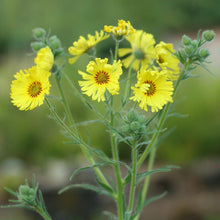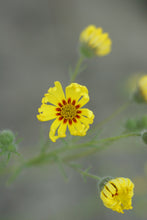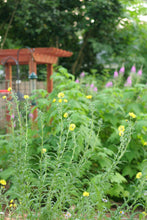
Madia elegans
Common Madia is a tall, strong plant with fragrant, yellow flowers that are pollinated by bumblebees, honey bees, butterflies, and other native insects. It has a relatively long bloom time that extends into late summer and even fall, making it an important late-season foraging resource, after many other native plants are done flowering. Its cheerful ray flowers will usually close in the heat of mid-day, and reopen in the mornings and evenings.
- Plant type/canopy layer: deciduous, annual, herbaceous plant
- Size at maturity: 24-48” tall, 12-24” wide
- Light requirements: full sun to part shade
- Moisture requirements: dry to moist soil
- Bloom time: June - August, longest blooms with moisture availability
- Growth rate/ease: fast growing, easy to grow
- Wildlife support: flowers attract and provide nectar to adult butterflies, bees and other insect pollinators; overall plant attracts and supports beneficial and pest eating insects
- Native habitat/range: common in grasslands, meadows, open sites in shrublands, forests, disturbed areas, from sea level to 2700m, across western Oregon and northwestern California. Portland Plant List - no.
- Special features & uses: fragrant; edible, seeds/achene is a traditional food source for indigenous people; landscape uses include pollinator gardens and meadowscapes
Gardening with Common Madia: Common Madia is an attractive, carefree, self-sowing annual wildflower. Plan for its tall and wild form by placing it in the background of a sunny pollinator garden or other naturescaped area, where its lovely blooms can peek above lower plants that provide more structure in the foreground. It tolerates all soil types and does not need supplemental summer water - though infrequent watering (i.e. not more than 1x per month) will extend the showy, pollinator-friendly bloom into fall.
Seed Packet Contains: approximately 150 seeds
Seed Sowing Instructions: Recommend sowing between September and November or in March so that seeds will benefit from seasonal rains. If sowing in April or May, seeds will benefit from supplemental water to encourage strong growth the first year. Scatter seed on loose-weed free soil. Seed can be lightly raked in to increase seed-to-soil contact, but be careful not to cover the seed with more than 1/4" soil.
Photo Credit 1, 2 & 4: Karli Del Biondo, Beetles and Bees
Photo Credit 3: "Madia elegans" by mypubliclands is licensed under CC BY 2.0







